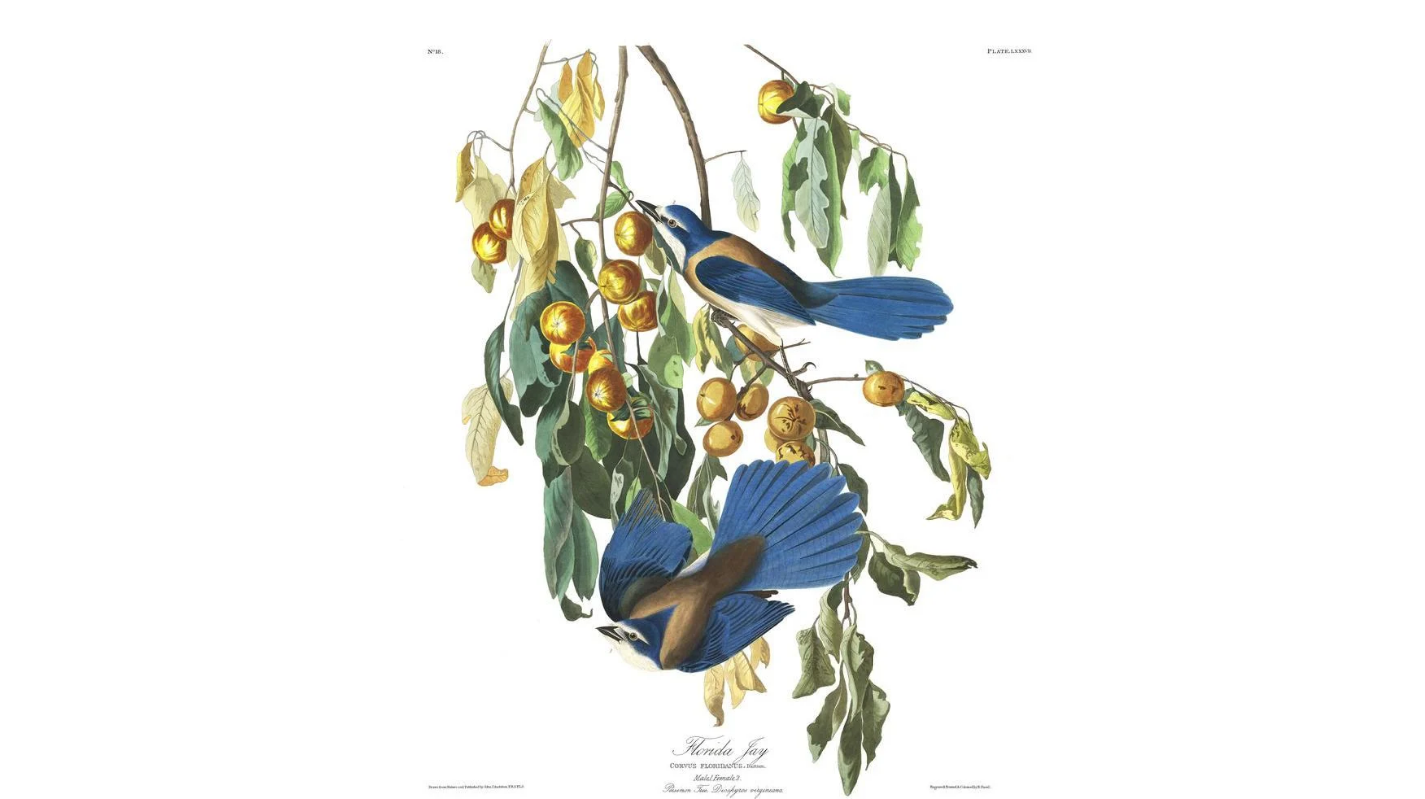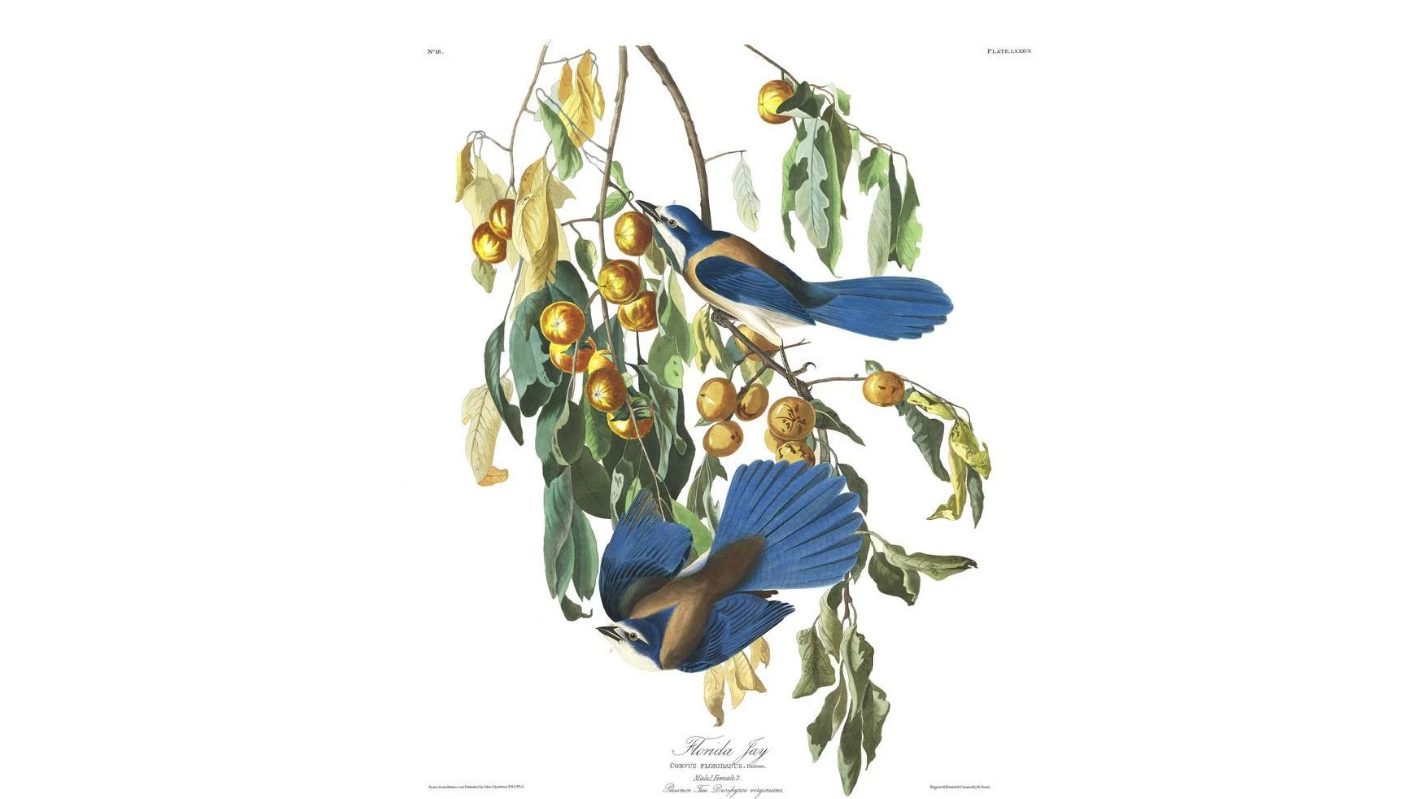ANTONIO RAIMO GALLERY
John James AudubonLeipzig Ed.Florida Jay Print Lithograph Engraving 1973 Germany Birds of America Collection
John James AudubonLeipzig Ed.Florida Jay Print Lithograph Engraving 1973 Germany Birds of America Collection
Couldn't load pickup availability
This beautiful and lively bird is a constant resident in the south-western parts of Florida, from which country it seldom if ever removes to any great distance. It is never seen in the State of Louisiana, far less in that of Kentucky, and when CHARLES BONAPARTE asserts that it occurs in these districts, we must believe that he has been misinformed. It is so confined to the particular portions of Florida which it inhabits, that even on the eastern shores of that peninsula few are to be seen. I have never observed it in any part of Georgia, or farther to the eastward.
The flight of the Florida Jay is generally performed at a short distance from the ground, and consists either of a single sailing sweep, as it shifts from one tree or bush to another, or of continuous flappings, with a slightly undulated motion, in the manner of the Magpie (Pica melanoleuca) or of the Canada Jay (Garrulus canadensis). Its notes are softer than those of its relative the Blue Jay (Garrulus cristatus), and are more frequently uttered. Its motions are also more abrupt and quicker. It is seen passing from one tree to another with expanded tail, stopping for a moment to peep at the intruder, and hopping off to another place the next minute. It frequently descends to the ground, along the edges of oozy or marshy places, to search for snails, of which, together with berries of various kinds, fruits and insects, its food consists. It is easily approached during the breeding season, but is more shy at other times. It is a great destroyer of the eggs of small birds, as well as of young birds, which it chases and kills by repeated blows of its bill on their heads, after which it tears their flesh with avidity.
The Florida Jay is easily kept in a cage, where it will feed on recent or dried fruits, such as figs, raisins, and the kernels of various nuts, and exhibits as much gaiety as the Blue Jay does in a similar state. Like the latter, it secures its food between its feet, and breaks it into pieces before swallowing it, particularly the acorns of the live oak, and the snails which it picks up among the sword palmetto. No sooner have the seeds of that plant become black, or fully ripe, than the Florida Jay makes them almost its sole food for a time, and wherever a patch of these troublesome plants are to be seen, there also is the Jay to be met with. I have called the palmetto a troublesome plant, because its long, narrow, and serrated leaves are so stiff, and grow so close together, that it is extremely difficult to walk among them, the more so that it usually grows in places where the foot is seldom put without immediately sinking in the mire to a depth of several inches.
The nest of the Florida Jay is sparingly formed of dry sticks, placed across each other, and, although of a rounded shape, is so light that the bird is easily seen through it. It is lined with fibrous roots, placed in a circular manner. The eggs are from four to six, of a light olive colour, marked with irregular blackish dashes. Only one brood is raised in the season.
I had a fine opportunity of observing a pair of these birds in confinement, in the city of New Orleans. They had been raised out of a family of five, taken from the nest, and when I saw them had been two years in confinement. They were in full plumage, and extremely beautiful. The male was often observed to pay very particular attentions to the female, at the approach of spring. They were fed upon rice, and all kinds of dried fruit. Their cage was usually opened after dinner, when both immediately flew upon the table, fed on the almonds which were given them, and drank claret diluted with water. Both affected to imitate particular sounds, but in a very imperfect manner. These attempts at mimicry probably resulted from their having been in company with parrots and other birds. They suffered greatly when moulting, becoming almost entirely bare, and required to be kept near the fire. The female dropped two eggs in the cage, but never attempted to make a nest, although the requisite materials were placed at her disposal.

-
Shipping
Share the details of your shipping policy.
-
Returns
Share the details of your return policy.
Image with text
Pair text with an image
Pair text with an image to focus on your chosen product, collection, or artist. Add details on availability, style, or even provide a review.
Image with text
Pair text with an image to provide extra information about your brand or collections.

